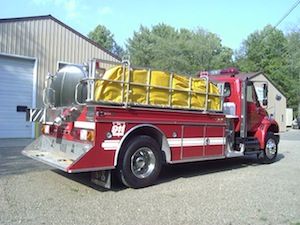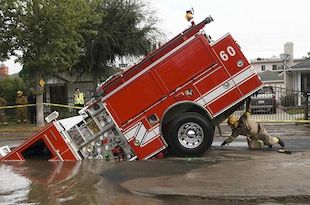Where a fire apparatus is parked plays an important role in how well its crew can operate on the emergency scene. Its positioning usually will dictate what tactics can be used to combat the fire or emergency.
It is the officer’s and driver’s responsibility to plan ahead with respect to what operations will be needed so that they can park the apparatus in an effective manner. Let’s look at some simple points with respect to how ineffective parking can hinder our operations thus handicapping ourselves.
This video shows how positioning the apparatus can influence ground-ladder operations. Truck and engine companies sometimes have their ground ladders stored in the apparatus’ enclosed compartments; the ladder must be pulled completely from the compartment.
A 24-foot extension ladder will be 14 feet long when bedded, thus needing about 15 feet to be pulled off. In the video the space between the two fire apparatus is enough to allow the ground ladder to be pulled off without any problems.
If the space were a little closer, the ground ladder could not have been pulled off, rendering it useless. Ensure you leave enough room between fire apparatus so that ground ladders can be pulled off.
The same spacing requirements hold true for ladders that are affixed to remote arms that bring the ladder down from the top or from the side. They need to have enough space to operate and enough space to pull the ladder off.
 |
Portable water tanks have similar space requirements. In this photo you can see the portable water tanks located on the side of the fire apparatus. One style uses a remote arm to bring the tank down. However, some water tank is stored inside the compartment of the fire apparatus.
Knowing the length of the water tank will pay off when parking the apparatus behind another one. Enough space will be needed to be able to pull off the water tank.
If using an aerial apparatus, enough space will be needed for the outriggers to be deployed. If two fire apparatus are parked side by side with one of them being an aerial device, there will need to be enough space between them both to allow for the outriggers to be fully deployed. Knowing the distance the outriggers take will help in this area or remove the possibility altogether by not parking the two trucks side by side.
Parking the fire apparatus too close to the edge of the roadway or too close to the emergency scene can sometimes hinder our ability to operate. When the roadway has a steep drop on the shoulder, parking the apparatus too close to the edge will limit our access to the equipment on that one side. When we park too close into the scene, we sometimes become a part of the scene.
 |
It is important to remember that other vehicles that may need access to the emergency scene, such as police, EMS, or utilities vehicles. How the fire apparatus is parked may block access to these other vehicles, which may prevent an ambulance from getting close enough to render fast care to a fallen firefighter or rescued civilian.
Occasionally, it is fire apparatus that is blocked by other vehicles from gaining access to an emergency scene. Be sure it is not the apparatus that is doing the blocking.
When we are arriving on the scene of our emergency, take the extra second or two to plan out where you are going to park the apparatus so that we remove the dominos leading us to becoming handicap.












